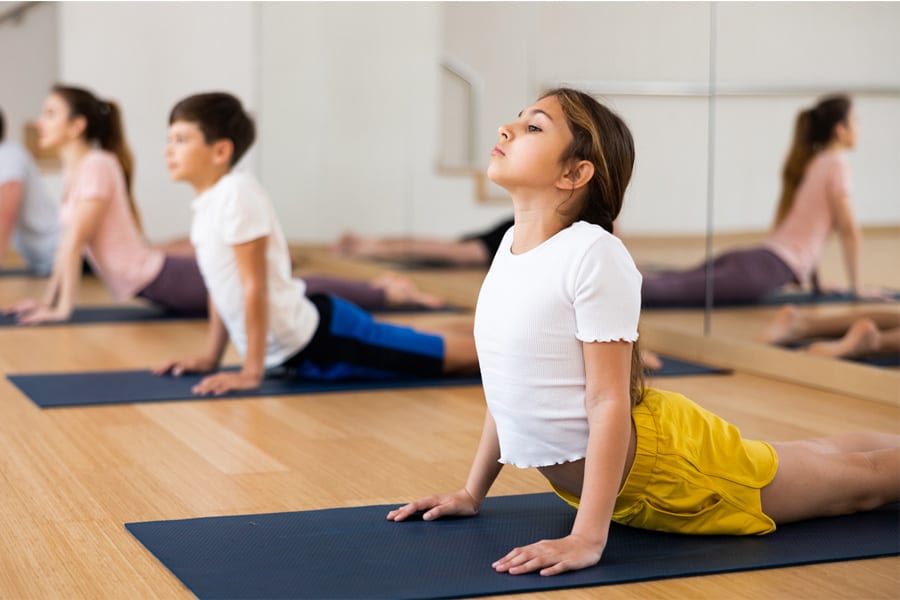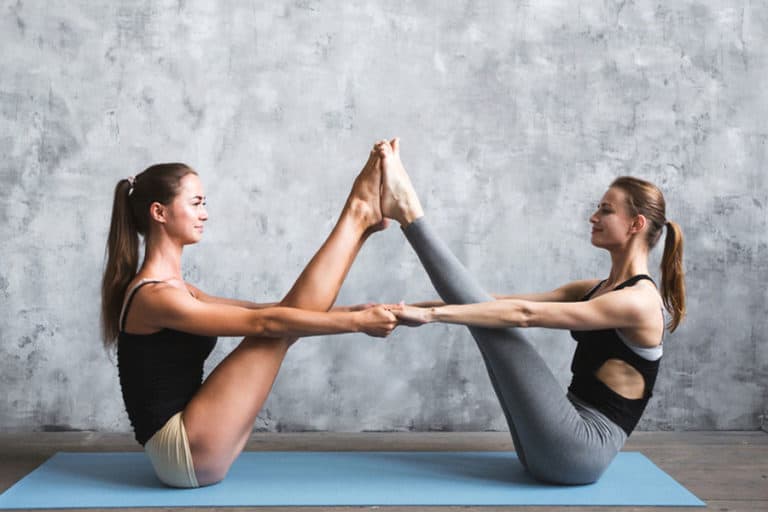Yoga For Teens – 9 Best Yoga Poses (Beginners To Advanced)

Yoga for teens | Reasons | Safety measures | types of yoga
One of the most challenging yet exciting periods of one’s life is the teen years. However, the surge of hormones and rapid bodily changes make it extremely difficult to retain emotional stability and maintain physical well-being.
By practicing yoga regularly, teenagers can learn to manage these mental, emotional, and physical fluctuations.
Best poses of Yoga for teens
Given below are 9 yoga poses for teens to include in their yoga practice:
1. Mountain pose
Level of yoga pose: Beginner
How to do
- Stand straight with your feet slightly apart on a yoga mat.
- Your feet should firmly balance your weight.
- Breathe in and move both your arms straight above your head or keep them loose beside your torso with palms facing in or forward.
- Ensure your torso is upright and your chin is parallel to the floor.
- Hold the pose for 30 secs and continue breathing in and out gently.
Summary: The mountain pose works as a foundation for all standing poses. It is a great pose to promote posture, improve self-esteem and enhance flexibility.
2. Corpse pose
Level of yoga pose: Beginner
How to do
- Lie flat on your back with your eyes closed.
- Keep your feet slightly apart with your toes pointing outwards.
- Keep your hands comfortably away from your body with the palms facing upwards.
- Bring your attention to each part of your body while intentionally relaxing it.
- Breathe in and out gently as you lay there for about 10-12 mins.
- Roll to your right and stay there for a while, breathing at the same pace.
- With the support of your right hand, assist yourself in the sitting position and gently open your eyes.
Summary: The corpse pose works well for releasing stress as the pose allows the mind and body to relax completely. This thus helps reduce blood pressure and eventually improve blood circulation. It is also an excellent pose for teens struggling with anxiety and insomnia, which then helps with better sleep quality and circulation.
3. Child pose
Level of yoga pose: Beginner
How to do
- Begin the pose by sitting on your knees with your hips resting on your heels.
- Stretch and bend your torso forward and bring your forehead to the floor.
- Let your arms lay by your side next to your hips with the palms facing up.
- Stay in this position for about 30-60 seconds while breathing at a steady pace.
- Slowly lift your torso up and return to the starting position to come out of the pose.
Summary: The child pose helps to improve flexibility in the lower back as it lengthens the spine and opens the hips. It also stimulates blood flow in the head and neck. Moreover, it stimulates the digestive system. Thus it may potentially relieve constipation.
4. Lotus pose
Level of yoga pose: Beginner
How to do
- Sit with your leg stretched in front of you.
- Bend your right knee, grab your right foot and place it on your left thigh close to your hip bone.
- Similarly, bend your left knee and place your left foot on your right thigh close to your hip bone.
- Now, straighten your back and keep the spine straight.
- Place your hand on your knees with your palms facing up and join your thumb and index finger together.
- With closed eyes, relax and focus on breathing in and out in the same position for a while.
- Hold the pose for 5 minutes or as long as you wish to stay in the meditative state.
Summary: The lotus pose is a relaxing pose that helps keep blood pressure in control. It also helps improve focus. Keeping the torso upright helps maintain a good posture. This pose also helps people suffering from problems like sciatica.
5. Wind-relieving pose
Level of yoga pose: Intermediate
How to do
- Begin by laying on your back and breathing gently.
- Exhale and lift both your legs straight up towards the ceiling.
- Slowly bend the legs and bring your knees close to your chest.
- Clasp your legs with both your hands and press your thighs to your chest.
- Continue to breathe steadily as you lift your head and chest off the floor.
- Attempt to touch your head to your knees.
- Hold the pose for 15-20 seconds.
- You may also rock from side to side while you are in the pose.
- Release your clasp and stretch out your legs to move out of the pose.
Summary: This pose combats digestive problems like gas and bloating. It also gives a good stretch to the lower back and strengthens the back muscles.
6. Standing forward fold
Level of yoga pose: Intermediate
How to do
- Initiate the pose by standing straight and breathing steadily. Rest your hands on your hips if you need to.
- Exhale, lengthen your spine, and bend forward from your hips, attempting to touch your head to your knees.
- Try not to bend your knees for maximum benefit.
- Try to touch your palms/fingers to the floor or hold on to your ankles.
- Continue to breathe gently and hold the pose for 20-30 seconds.
- To move out of the position, release your hands off your ankles and gently move your torso upwards.
Summary: This pose gives a deep stretch to the hamstrings. Moreover, it relieves the spine and lower back tension, thus improving lower body flexibility.
7. Seated forward bend
Level of yoga pose: Intermediate
How to do
- Sit with your spine erect, and your legs stretched out in front of you.
- Inhale and raise both your hands straight above your head.
- Stretch your back, breathe out and bend your upper body forward. Hold your feet/toes (whichever you can reach comfortably) with your hands.
- For maximum benefits from this pose, your chest must lay flat on your thighs, and your head should rest between your knees. However, progress steadily in achieving this stage.
- Hold the pose for 30-60 seconds.
- Release your hands off your feet/toes and inhale as you move upwards to the upright position to get out of the pose and exhale deeply.
Summary: The seated forward bend provides a good stretch to the entire back (neck, upper back, spine, hips, glutes, hamstrings, and calves). This helps calm the nervous system, which helps relieve stress. Moreover, it also tones the lower abdomen and stimulates the reproductive organs.
8. Downward-facing dog pose
Level of yoga pose: Intermediate
How to do
- Begin with your hands and knees resting on the mat, your thighs perpendicular to the floor, and your upper body parallel to the floor.
- Keep your head in line with your spine.
- Press onto your toes and push your butt towards the ceiling.
- Slowly lengthen your spine and straighten your hamstrings such that you form a triangle with your body.
- Press your palms to the floor and allow your heels to touch the floor. You should feel a good stretch to your hamstrings and spine at this point.
- Gaze towards your navel.
- Breathe steadily throughout the movement.
- Hold the pose for 30-60 seconds and release.
- To move out of the pose, lower your hips and kneel on the floor, transition into the child pose, and sit up.
Summary: The downward-facing dog helps to stretch the entire body, from your fingertips to your toes. It also improves your arm strength as the exercise requires you to bear your upper body weight on the arms. Moreover, it stimulates better blood circulation as the heart is above the head. Thus, gravity pulls the blood flow downwards, resulting in more oxygenated blood reaching the brain.
9. Extended hand-to-big-toe pose
Level of yoga pose: Advanced
How to do
- Stand erect on the yoga mat.
- Bend your right knee and bring the right foot towards your abdomen and grasp the toes with your right hand from the inside.
- Holding on to the toes, extend the right leg, ensuring that your right knee is straight.
- If you want to try a deeper stretch, stretch your right leg outwards instead.
- Breathe steadily throughout the movement and stay focused to hold the pose for 10-15 seconds.
- Bend the extended leg and bring the foot back towards the abs, release your hands off your toes and lower the foot down to come into the standing position.
- Repeat the same on the other side.
Summary: The extended hand-to-big-toe pose improves focus and balancing skills. Moreover, performing this yoga sequence gives a deep stretch to the hamstrings, back, and ankles, thus making the lower body muscles stronger over time.
Related Articles
Why should teens do yoga? – Problem and solution
It is necessary to understand why it is integral for teenagers to perform yoga. Given below are the common challenges teens face and how yoga can be beneficial to those:
1. Weight gain
Weight gain is a common problem during the teen years as the body undergoes various changes. Obesity impacted about 14.7 million [1]Centers for Disease Control and Prevention: Childhood Obesity Facts children and adolescents in the year 2017-2020 in America.
Children/teens who are obese tend to develop other health problems like type 2 diabetes, hypertension, sleep apnea, etc.
Yoga can be effective in losing weight and keeping the body toned and fit.
The breathing techniques used in yoga help improve the oxygen level in the body, which helps the body to get warmed up. This speeds up the metabolic process and aids in losing weight.
2. Anxiety and stress
Teens are under a lot of pressure to perform well academically and socially. This may be because of several reasons like parental or peer pressure, academic competition, etc.
This can lead to anxiety and stress, which, if not dealt with in the right way, can lead to long-term mental health issues like depression.
Yoga has the ability to regulate the nervous system [2]PubMed: Effects of yoga on the autonomic nervous system, gamma-aminobutyric-acid, and allostasis in epilepsy, depression, and post-traumatic stress disorder, which helps to relieve stress and anxiety. In addition, certain yoga poses help improve concentration and focus, which can benefit teenagers academically.
3. Poor self-esteem and body image issues
Hormonal changes cause teenagers to go through physical changes like outbursts of acne and weight gain. This may cause the teens to develop body image issues. Moreover, peer pressure and bullying are common issues during the teen years, leading to poor self-esteem [3]Frontiers: Yoga Poses Increase Subjective Energy and State Self-Esteem in Comparison to ‘Power Poses’.
Certain yoga asanas particularly work on your balance and require you to control your body through movement. It makes you more confident over time.
Practicing yoga and meditation can help teenagers become more accepting of their bodies and develop a positive body image.
4. Insomnia
It is common for teenagers to have trouble sleeping at night. This can be because of stress, anxiety, late-night phone usage, irregular sleep patterns, hormonal fluctuations, etc. This can lead to fatigue and sleep deprivation, further worsening academic performance.
There are particular yoga poses for relaxing the mind and body, which can help treat insomnia.
Studies [4]National Library of Medicine: Impact of long term Yoga practice on sleep quality and quality of life in the elderly have proven that yoga can help develop regular sleep patterns and develop a stable circadian rhythm.
Safety measures to take
According to the American Academy of Pediatrics [5]National Center for Complementary and Integrative Health: Yoga for Health, yoga is an effective and safe therapy for teenagers to overcome common challenges faced during this period of life.
However, certain precautions must be taken while starting yoga at this age:
- Teens with prior injuries, recent surgeries, or pre-existing medical conditions should consult a doctor before beginning any yoga practice.
- Choose a yoga class/yoga studio with a certified yoga instructor who understands teenagers’ needs.
- Start gradually and increase the intensity of your practice steadily.
- Listen to your body, and do not push yourself beyond your limits. Stop the yoga session if you feel pain or discomfort, and inform your instructor.
- Do not practice yoga immediately before or after having your meal, as it can lead to indigestion.
- Do not practice yoga without understanding the correct philosophy of that particular yoga type. For instance, hot yoga may overheat your body and cause dehydration.
Different types of yoga
To understand each yoga pose better, it is best to know some fundamental types of yoga and how they function:
- Bikram yoga/Hot yoga: It is practiced in a room with a temperature of around 105° F and 40% humidity. The high temperature allows the body to sweat out toxins and release muscle tension.
- Hatha yoga: This is the basic form of yoga and involves different generic yoga asanas.
- Iyengar yoga: This form of yoga is based on precise alignment. It uses props such as blankets, blocks, and straps to help the body achieve the correct alignment in each pose.
- Power yoga: It is an athletic form of yoga that builds muscle strength and increases stamina.
- Restorative yoga: It is a very gentle and relaxing form of yoga that uses props to support the body in each pose.
- Viniyoga: It is a slow and gentle form of yoga focusing on breathwork.
- Yin yoga: It is a very slow form of yoga that focuses on holding passive poses for a long duration of time. This allows the connective tissues to stretch and heal.
Conclusion
Yoga is a holistic approach that can help teenagers to overcome many common challenges faced during this crucial phase of life. However, it is important to understand the philosophy of each yoga type and take certain safety measures before beginning the practice.
It is best to join yoga classes to get the perfect guidance from professional yoga instructors. Moreover, watching yoga videos will also help you learn the correct form precisely for you to design your own exercise program.
References
| ↑1 | Centers for Disease Control and Prevention: Childhood Obesity Facts |
|---|---|
| ↑2 | PubMed: Effects of yoga on the autonomic nervous system, gamma-aminobutyric-acid, and allostasis in epilepsy, depression, and post-traumatic stress disorder |
| ↑3 | Frontiers: Yoga Poses Increase Subjective Energy and State Self-Esteem in Comparison to ‘Power Poses’ |
| ↑4 | National Library of Medicine: Impact of long term Yoga practice on sleep quality and quality of life in the elderly |
| ↑5 | National Center for Complementary and Integrative Health: Yoga for Health |



